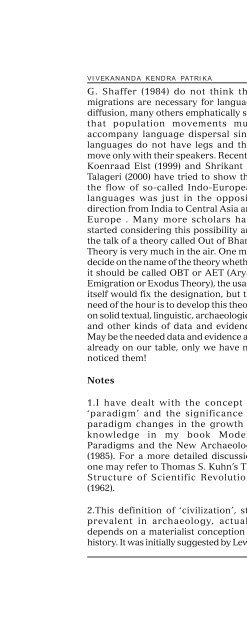Aryan Invasion Theory - Publication - Vivekananda Kendra
Aryan Invasion Theory - Publication - Vivekananda Kendra
Aryan Invasion Theory - Publication - Vivekananda Kendra
Create successful ePaper yourself
Turn your PDF publications into a flip-book with our unique Google optimized e-Paper software.
VIVEKANANDA KENDRA PATRIKA<br />
G. Shaffer (1984) do not think that<br />
migrations are necessary for language<br />
diffusion, many others emphatically say<br />
that population movements must<br />
accompany language dispersal since<br />
languages do not have legs and they<br />
move only with their speakers. Recently,<br />
Koenraad Elst (1999) and Shrikant G.<br />
Talageri (2000) have tried to show that<br />
the flow of so-called Indo-European<br />
languages was just in the opposite<br />
direction from India to Central Asia and<br />
Europe . Many more scholars have<br />
started considering this possibility and<br />
the talk of a theory called Out of Bharat<br />
<strong>Theory</strong> is very much in the air. One may<br />
decide on the name of the theory whether<br />
it should be called OBT or AET (<strong>Aryan</strong><br />
Emigration or Exodus <strong>Theory</strong>), the usage<br />
itself would fix the designation, but the<br />
need of the hour is to develop this theory<br />
on solid textual, linguistic, archaeological<br />
and other kinds of data and evidence.<br />
May be the needed data and evidence are<br />
already on our table, only we have not<br />
noticed them!<br />
Notes<br />
1.I have dealt with the concept of<br />
‘paradigm’ and the significance of<br />
paradigm changes in the growth of<br />
knowledge in my book Models,<br />
Paradigms and the New Archaeology<br />
(1985). For a more detailed discussion<br />
one may refer to Thomas S. Kuhn’s The<br />
Structure of Scientific Revolutions<br />
(1962).<br />
2.This definition of ‘civilization’, still<br />
prevalent in archaeology, actually<br />
depends on a materialist conception of<br />
history. It was initially suggested by Lewis<br />
30<br />
ARYAN INVASION THEORY<br />
H. Morgan in 1877 in his book Ancient<br />
Society, or Researches in the Lines of<br />
Human Progress from Savagery through<br />
Barbarism to Civilization. Frederick<br />
Engels adopted this definition in his<br />
famous essay ‘The Origin of the Family,<br />
Private Property and the State’ written<br />
in German which appeared in Zurich in<br />
1884 wherefrom it was applied in the<br />
field of archaeology by V. G. Childe. The<br />
definition is defective in several respects,<br />
but we need not elaborate the points<br />
here. Suffice it to say that a definition<br />
given from a particular view-point<br />
cannot hold good for others who do not<br />
accept that point of view.<br />
3. An example of the persisting notion of<br />
culturally backward and warlike Early<br />
<strong>Aryan</strong>s may be found in R.S. Sharma’s<br />
book Material Culture and Social<br />
Formations in Ancient India published in<br />
1983. Sharma has concluded that down<br />
to the time of composition of the Family<br />
Books of the Rigveda, the Vedic <strong>Aryan</strong>s<br />
were largely nomadic pastoralists<br />
ignorant of settled agriculturists’ life and<br />
were engaged mostly in booty capture.<br />
According to him, booty capture was<br />
their most important economic<br />
institution. On page 38 of his book he<br />
declares: ‘War in the predominantly<br />
tribal society of the Rg Veda was a logical<br />
and natural economic function’ and that<br />
it was ‘the main source which supplied,<br />
to the tribal chief or prince, cattle, other<br />
animals and women in the shape of<br />
spoils’. On page 24 of the book, he opines<br />
that ‘the Family Books show the Rig<br />
Vedic people to be predominantly<br />
pastoral’. But R. N. Nandi contradicts this<br />
statement and notes: ‘Not much exercise<br />
is needed to show that permanent

















